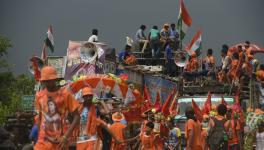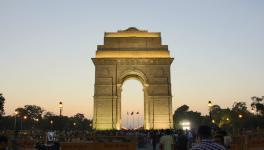Babri Verdict’s Discordant Notes Signal Future Conflicts

Image Courtesy: Outlook India
The verdict of the five-judge bench of the Supreme Court on the Ayodhya title suit has many absurdities that need to be articulated. Hopefully, pointing them out will help strengthen our judiciary.
One of these is the “reparation” mentioned in the verdict, namely the award of five acres of land in Ayodhya to recompense the criminal act of demolishing a heritage structure, the Babri mosque. The court does not specify where the plot of land would be. Nor is there a time frame for its implementation. Possibly going beyond the scope of the petition, the Supreme Court has asked the government to create a trust within three months, which will facilitate the construction of the temple.
It is a matter of concern that the government is being asked to create a trust only for the Hindu temple and not for the Muslim mosque? After all, it is the mosque which was demolished. That this has come from a five-judge bench of the apex court and not from a vote-seeking populist political party, makes it even more conspicuous. For, even this specific component of the judgment can possibly be read as discriminatory against Muslims. Yet this particular act is being paraded as judicial magnanimity and one more testament to India’s secularism and pluralistic tolerance.
The verdict clearly says, “Justice would not prevail if the court were to overlook the entitlement of the Muslims who have been deprived of the structure of the mosque through means which should not have been employed in a secular nation committed to the rule of law. The Constitution postulates the equality of all faiths. Tolerance and mutual co-existence nourish the secular commitment of our nation and its people”.
The court verdict in the Ayodhya dispute is, we are told, one of the longest judgments till date, running into 1045 pages, 805 paragraphs, 3.03 lakh words and a 116-page addenda that just explains “whether the disputed structure is the holy birth place of Lord Ram as per the faith, belief and trust of Hindus?”
Moreover, in Part P of the judgement, while pronouncing criminality of the demolition of the Babri masjid, the verdict reduces (on paragraph 800 of page 922) the issue to be an offence against the Muslims. It does not recognise the fact that the masjid was a heritage monument, and therefore its destruction is not merely an offence against just Muslims. A heritage monument is a national asset, meant to be protected as per Article 49 of the Constitution. India has even legislated a few Acts towards this.
While Muslims have been sought to be “compensated” with five acres land, the citizens concerned only with national monuments, who do not identify themselves with either of the two contesting parties, remain uncompensated. To put it conversely, the verdict supposedly dispenses justice to religious sentiments while it completely disregards the secular sentiments involved in the destruction of the shared heritage.
News reports tell us that the Chief Justice of India consulted the chief secretary of the Uttar Pradesh government before pronouncing the verdict. The implication is that there were some administrative concerns related to its pronouncement. Hence, the component of the verdict that pertains to Muslims should have been an important concern—meaning that it should have taken into account how the verdict would ultimately by implemented. In this case, the location of the proposed plot of five acres should have been specified in the pronouncement.
This is for several reasons. One, what if a group or groups of hot-headed majoritarian bigots pre-empt, impede or attempt to delay implementation of this specific “Muslim” component of the judgment? Second, what if the provincial government and the central government keep passing the buck to each other and thereby delay it, and three, people holding constitutional positions, such as the chief minister of Uttar Pradesh Yogi Adityanath, have already vowed to purge Ayodhya of Muslims. This is surely a matter of concern in implementing the verdict.
Another cause of concern is the “pacifists” who seem to be looking at a proposal that Muslims would not accept this five-acre “grant” of land as a signal of their being opposed to closing this longstanding dispute. The question is whether this offer of land signifies a feeling of guilt: If it is indeed so, then refusing it would not reduce the burden of guilt that is shared by the majority community and the judiciary.
Instead, I pose a question: Why could not the verdict stop at giving away the 2.77 acres of land under dispute either to the state or to Ram Lalla Virajman (which is actually the Vishwa Hindu Parishad), as the verdict has actually done—and leave the rest of the business to government?
Then comes the question of who has been allotted this undefined plot of land. To the best of my knowledge, in this country, the Sunnis and Shias have separate Waqf boards only in Bihar and Uttar Pradesh. And, while there is a Central Waqf Council, there does not exist a body known as the Central Sunni Waqf Board.
Yet, the verdict does not say that the land is to vest in the Uttar Pradesh Waqf Board. It talks about a Central Sunni Waqf Board, which is to receive this land. It remains a mystery who or what body will actually get this land, presumably on behalf of the Muslims who are being recompensed for the breaking of the Babri mosque. In any case, given the influence that the government of the day has on such boards, it is realistically unlikely that the offer of land will be turned down
It also remains to be seen what explanations the so-called pacifists would produce if or when majoritarian bigots stake their claim to other masjids, graveyards, and other sites associated with Muslims and Islam that are scattered across the country? Let us not forget that such forces are often getting state support these days. What implication will the details of this verdict and attempts to implement it have upon all these disputes, whether they are pre-existing or yet to be created? The world at large is already conversant with lists of such disputes and potential sites of provocative programmes. In how many ways will this verdict be invoked in future whenever these looming crises come in the foreground?
At this juncture it is instructive to revisit an instance from the Sikh worship site, the gurudwara Shaheedganj located at Lahore in Pakistan. This is not a secular country, nor is it known to espouse pluralistic values. Pakistan has no pretensions of this kind. The Shaheedganj dispute, over the co-location of a mosque, had raged on since 1935. But the court in Pakistan ruled in favour of the gurudwara. Even more significantly, local communities converged with the judicial verdict in favour of the Sikh minority. Earlier, in 1936, an attempt was made to overturn the court’s verdict through legislation, and (paradoxically?) Jinnah had opposed the move. Throughout this dispute, notwithstanding its majoritarianism and despite there being a colonial government, the Pakistani state remained neutral in letter and spirit. (In 2004, the gurudwara was also renovated.)
One hopes that our learned judges were not unmindful of the above mentioned concerns. We need to collectively introspect and evaluate if this verdict has really strengthened the process of secularisation or if it has unwittingly ended up harming this process.
The writer is professor of modern and contemporary Indian history at Aligarh Muslim University. The views are personal.
Get the latest reports & analysis with people's perspective on Protests, movements & deep analytical videos, discussions of the current affairs in your Telegram app. Subscribe to NewsClick's Telegram channel & get Real-Time updates on stories, as they get published on our website.
























